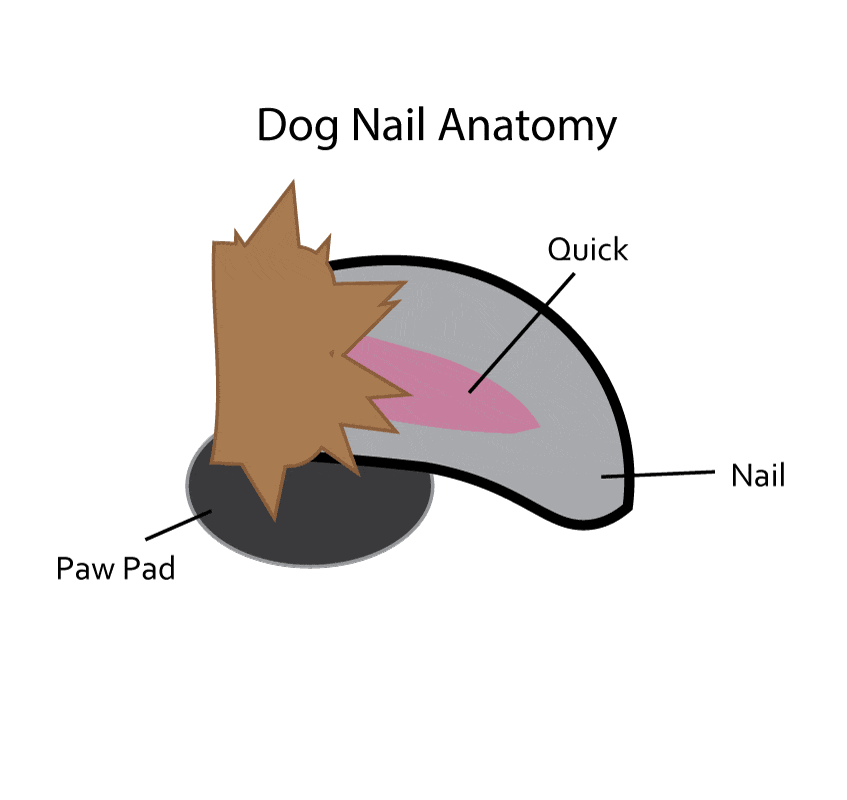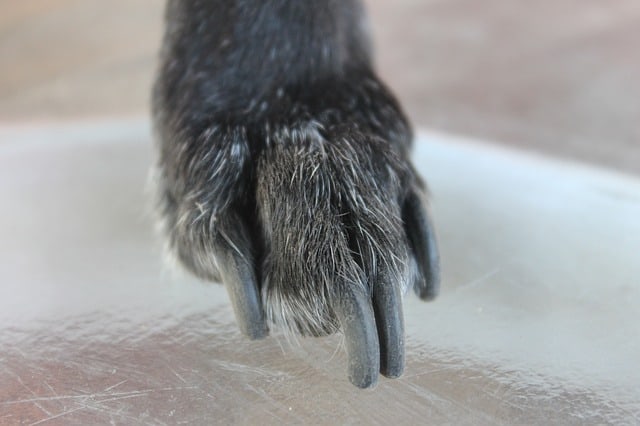Part of grooming your dog includes trimming her nails often. Dog nails grow at the speed of light.
To keep them short and safe, you need to snip them regularly.
Sadly, clipping a dog’s nails is not as easy as clipping human nails. When your nails need a trim, all you need is a good nail clipper and cut away as much of the nail as you please.
For dogs, the story is different. If you cut too short, you risk causing pain and bleeding. Improper trimming affects the dog’s musculoskeletal system.
Unless you understand the anatomy of your pooch’s nail, nail trimming can take a bad turn for you and the doggie.
To ensure that everybody is safe, we’ll reveal 15 things you didn’t know about your dog’s nails.
Dog Nail Anatomy Overview

Source: 1
- The nail is composed of two parts: the quick and the nail itself. The former is a soft network of blood vessels that supply the nail with nutrition and blood vessels. The latter is the physically hard and horn-like organ you see protruding from the paw. Since there are nerves past the quick, a dog doesn’t feel pain on the nail itself.
- A dog has four nails on each paw. The nail is located at the end of the toe facing forward right above the pad. At the toe, the nail is wider but it gets narrower as it grows out.
- The toenails consist of a protein referred to as keratin. This is what human nails are made of up as well. It also has blood vessels, nerve endings, muscles, and tendons that work together to create a very functional and useful body part for your mutt.
- The bones of the toenails are not as straight and flat as those of humans. Instead, they are sandwiched in a bent elastic balance between the flexor and extensor tendons. The nail is pulled off the ground by the paired dorsal ligaments attached to the end of the middle toe bone and the end of it. The nail only touches the ground when the dog is on the move and the flexor tendon is sufficient to overcome the force of the dorsal ligaments.

Source: 3
- For dogs, nails are attached to the phalanx bones located at the end of the toe. This is unlike human nails which merely sit on top of the fingers and grow from cuticles.
- Most dogs have white nails with a pink quick. Others have black toenails with equally black quicks. In rare circumstances, you will find a dog with both nail colors. Often, they will have one white nail with the rest being black.
- Canines use their nails to perform different things including scratching themselves or prey and gripping objects such as bones and toys. These also come in handy when burrowing in soft surfaces like sand and dirt. Also, as the dog walks or runs, the nails will help offer traction. Finally, nails are used alongside teeth to fight predators and other dogs.
The Quick

- The quick, also called the cuticle, is one of the most important parts of a dog’s nail. Without it, the nail will die as it will not have nutrition and blood supply. It is located in a precarious position and can be cut when trimming the nails. In such a case, bleeding and pain will occur. Unfortunately, the quick is hard to locate sometimes. Many pet parents end up clipping it alongside the nail.
- For dogs with white nails, the quick is visible from the outside of the toenail. It bears a pink color. When you examine your pup’s nail, the narrower outer part will be all white. However, as you go inside, you will see a tiny pink dot at the center which is the onset of the quick.
- While the quick is visible for white nails, it is not very visible for black nails. For one, you cannot see it from the top of the toenail. However, if you look closely at the underside of the nail, you will see a groove in the toenail where the hard cuticle turns into soft tissue. When trimming the nails, you want to avoid the black soft tissues also called the pulp.
Related Posts:
How to Find the Quick on Black Dog Nails
Declaws

Source: 2
- The declaw, or the thumb, is the extra nail on the inner part of a dog’s foot. Some dogs have declaws on their hind limbs with others featuring double declaws.
- The declaws provide extra traction when the dog is running at high speeds, negotiating a corner, or moving on slippery ground. The declaws touch the ground to stabilize the wrist (carpal) joint. Our canine friends can also use declaws to climb trees, get out of the water in icy situations, and hold objects when chewing them.
- Each declaw has tendons that connect it to the musculoskeletal system of the dog. You can feel the tendons when you move the declaw forward and backward. The tendons show that the declaws don’t sit pretty for nothing. They serve a function and should not be removed.
- Under rare circumstances, the declaws should be removed. For instance, if they are severely injured, dislocated, or infected by a disease like a cancerous tumor, removal would be in the canine’s interest.
- Certain breeds must have their declaws removed to qualify them for the show ring. If your dog is one of them, you will need to do the procedure before the doggie is 5 days old. Apparently, eliminating the declaws improves the appearance of the dog for the competition. Conversely, some breeds such as the Great Pyrenees cannot participate in the show ring without declaws.
Unless your canine friend runs around on a hard surface constantly, you will need to trim her nails at least once a week. As soon as you hear that easily distinguishable clicking sound, you know it would be time to trim.
With the right knowledge of how the nail looks, you can always get the job done to perfection without creating a bloody mess and inflicting pain on the doggie.
Related Posts:
Dog Paw Pad Peeling: A Quick Guide for New Pet Owners
10 Dog Breeds with Fur between Toes
Should You Trim the Hair between a Dog’s Pads?
As an Amazon Associate, we may receive a small commission from qualifying purchases but at no extra cost to you. Learn more. Amazon and the Amazon logo are trademarks of Amazon.com, Inc, or its affiliates.

